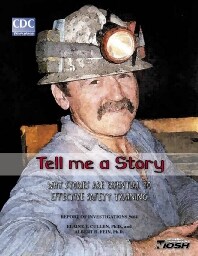Mining Publication: Tell Me a Story: Why Stories are Essential to Effective Safety Training
Original creation date: August 2005
Authors: ET Cullen, AH Fein
NIOSHTIC2 Number: 20028470
U.S. Department of Health and Human Services, Public Health Service, Centers for Disease Control and Prevention, National Institute for Occupational Safety and Health, DHHS (NIOSH) Pub. No. 2005-152, Report of Investigations 9664, 2007 Aug; :1-71
Federal law mandates that all miners receive safety and health training when first entering the mining industry and at least 8 hours annually thereafter. Although the mining industry has historically relied on an experiential master-apprentice model for training new employees, the formal safety training provided to miners is generally done in a classroom, with mixed results. In a series of stakeholder meetings held by NIOSH across the West in 1997-2000, trainers identified significant gaps in materials that were available to teach new and experienced miners. They asked whether NIOSH could develop effective materials to fill these perceived gaps, as well as make training more effective for those who were required to attend, but who often refused to be attentive. Adult learning theories, social learning theories, mentoring, and storytelling were all employed in the development of a series of safety training videos that have become very popular in the mining industry. This Report of Investigations describes the theoretical frameworks that were used, the process that was developed to produce the videos, and the results of the evaluations as to whether or not they were effective in training new and experienced miners.

NIOSHTIC2 Number: 20028470
U.S. Department of Health and Human Services, Public Health Service, Centers for Disease Control and Prevention, National Institute for Occupational Safety and Health, DHHS (NIOSH) Pub. No. 2005-152, Report of Investigations 9664, 2007 Aug; :1-71
- The Evolving Mining Workforce: Training Issues
- An Ounce of Prevention: Training Workers to Prevent a Crisis
- An Overview of Technology and Training Simulations for Mine Rescue Teams
- An Overview of the Evaluation Process for Mine Trainers
- A Performance Approach to Training Research
- Principles of Adult Learning: Application for Mine Trainers
- Tell Me A Story... Using Stories to Improve Occupational Safety Training
- Tell Me a Story: Using Narrative to Teach Safety to Skilled Blue-Collar Workers
- Tell Me a Story: Using Stories to Improve Occupational Safety Training
- Working in the Classroom - A Vision of Miner Training in the 21st Century